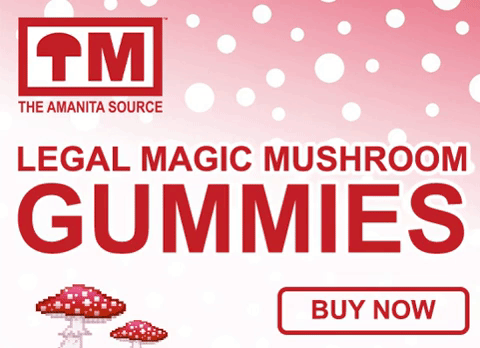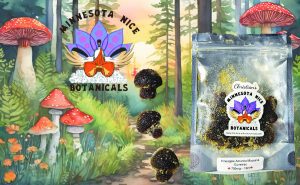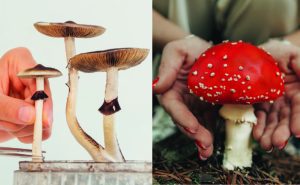Throughout the world, Amanita muscaria mushrooms have intrigued and mystified people with their exotic beauty and rumored psychoactive properties. This mushroom species is most commonly associated with its bright red cap dotted with white spots. While some may find this colorful fungus fascinating, it also comes shrouded in mystery, little is known about it or its effects on humans. And perhaps what has kept some from sampling its potentially psychedelic-inducing powers is the potential legal ramifications; Are Amanita muscaria mushrooms illegal? In this article, we’ll uncover the truth about these remarkable mushrooms and their legal status across the globe.
What are Amanita muscaria mushrooms, and where do they grow?
Amanita muscaria mushrooms are a mushroom species from the genus Amanita, native to much of the Northern Hemisphere. They typically grow in grassy areas and forests near birch, fir, pine, spruce, and other conifers. The caps of these mushrooms range from red to yellow-orange with white spots. The stem is white, and the underside of the cap has a network of gills.
Amanita muscaria mushrooms contain psychoactive compounds that can cause hallucinogenic effects in some individuals who ingest them. However, some people have reported positive experiences with this species. For example, some Native American tribes use Amanita muscaria mushrooms in religious and spiritual ceremonies. While they can be dangerous when ingested, these mushrooms can also be a source of natural beauty and wonder.
The mushroom is also a popular symbol and is featured in many works of art, literature, film, music and one very famous Mario Brothers video game. Its popularity stems from the fact that it is one of the most recognizable mushrooms in the world!
What are the effects of consuming Amanita muscaria mushrooms?
The effects of consuming Amanita muscaria mushrooms can vary depending on certain factors, including the age and size of the mushroom, when it was harvested, and environmental conditions such as temperature, altitude, and soil composition. Common effects may include changes in perception of time and space, visual distortions, euphoria, nausea, drowsiness, or excitement.
Some people may also experience dizziness, increased heart rate and breathing, changes in body temperature, and sweating. In rare cases, Amanita muscaria mushrooms can cause more severe reactions such as delirium, seizures, or even death if consumed in large quantities..
It is important to be aware of the potential effects of consuming these mushrooms, as they can be unpredictable and potentially dangerous. If you do choose to experiment with Amanita muscaria mushrooms, it is best to do so in a safe environment, with someone with experience in their use and under the supervision of an experienced healthcare provider.
The article we wrote about the top 5 Amanita Muscaria companies highlights what products can be trusted and purchased online. We encourage you to visit these websites and shop for trusted Amanita muscaria products online.

Are Amanita muscaria mushrooms illegal to possess or consume?
The answer to whether Amanita muscaria mushrooms are illegal to possess or consume in the United States is a bit more complicated. They are not explicitly illegal, but they can be hard to find and sometimes contain toxins that could be dangerous if consumed in large quantities. In the US, the legality of Amanita muscaria mushrooms varies by state. Although most US states DO allow the possession and/or cultivation of these mushrooms, some states still have prohibitions against their use.
We’ve identified the top 5 Amanita muscaria products being sold online that can be consumed and enjoyed as recreational enjoyment.
In other countries around the world, Amanita muscaria mushrooms may also be prohibited by law due to their psychoactive effects. In Germany, for example, possessing and consuming these mushrooms is illegal. Similarly, these mushrooms are illegal in several other countries, such as Japan and Saudi Arabia. It is important to check with local laws before possessing or consuming any type of wild mushroom. In some cases, seeking legal advice may be necessary to ensure compliance with local regulations.
Overall, Amanita muscaria mushrooms may not always be explicitly prohibited by law in the US and other countries. Still, it is important to be aware of local laws and the potential risks associated with consuming them. It is also important to remember that these mushrooms can contain toxins if consumed in large quantities, so they should be handled cautiously.
How can you tell if an Amanita muscaria mushroom is poisonous or not?
To determine if an Amanita muscaria mushroom is poisonous, you should look for some key identifiers:
- Color: The Amanita muscaria mushroom’s bright red cap often fades to yellow or orange with age. Poisonous mushrooms may also be white or yellowish.
- Texture: The top of the mushroom should feel dry and powdery, not slimy or sticky.
- Size: Amanita muscaria mushrooms are typically larger than other poisonous mushrooms found in the same area.
- Smell: Poisonous Amanita muscaria mushrooms have a unique odor that can be described as sweet and musky.
If you find a mushroom that meets the above criteria, it is important to be extremely cautious and never consume it unless you are certain of its safety.
The article, “How To Safely Eat Amanita Muscaria?” highlights the importance of properly preparing your Amanita muscaria mushrooms for consumption.
There’s a very informative video on the Quebec Homestead channel that outlines Amanita muscaria and all its medicinal properties. Watch the Amanita muscaria video here.
What should you do if you think you’ve consumed a poisonous mushroom?
Immediately seek medical help. If possible, you should also bring a sample of the mushroom with you. Contact your local poison control center immediately if you or someone else has been poisoned by consuming a poisonous mushroom. Be prepared to provide information on where and when the mushrooms were collected and how they were prepared or ingested.
Knowing what type of mushroom was consumed can help doctors determine which specific toxins are present and suggest the most appropriate medical treatment. The sooner you seek medical attention, the better chance of successful recovery for the person who has been poisoned. It is also important to be aware that some people are more sensitive to certain toxins than others, so it is best to avoid caution when consuming any type of mushroom.
Additionally, never eat a mushroom raw, and make sure all mushrooms are cooked thoroughly before consumption. Following these simple tips can help ensure your safety when foraging or consuming wild mushrooms.
We’ve included some books that can help you properly identify a Amanita muscaria mushroom when foraging:
Final Words
Amanita muscaria mushrooms have been used in many cultures for religious and medicinal purposes . These Mushrooms are not illegal in most of the US. They can be grown, bought, sold, and possessed in most countries worldwide. The United States has no federal laws against them, which are legal in all 50 US states, with the exception of Louisiana. Some cities have local laws against them, so it is important to check your municipal laws before consuming or possessing these mushrooms.
Nate
Nate is a longtime contributor to many cannabis, hemp and psychedelic related websites including Amanita Info. His passions include small business, the psychedelic industry and its positive role in mental health. When he isn't writing he enjoys working out and watching the history channel.








